Macpherson Family
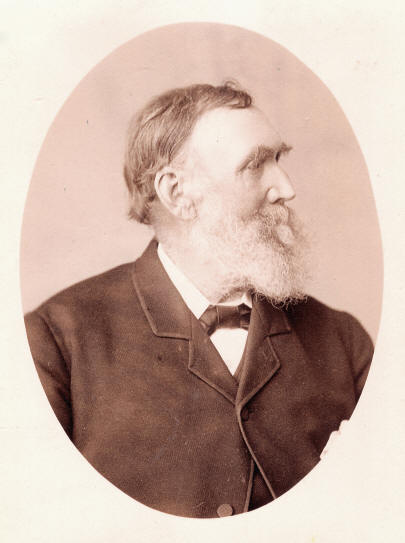
Duncan and Mary Macpherson left the highlands of
Scotland in 1846 to start a new life in South Australia. Two years later
they moved to the 13-year-old Swan River Colony of Western Australia. Duncan took up
farming at Newcastle (now Toodyay) and with his wife raised a family of
two daughters and seven sons.
After being evicted from their leased property, they left Newcastle in 1868 and shifted through the bush and scrub with horses and bullock wagons. They started over near the Mulliah or Yarra Yarra Lakes, in an unnamed district considered an unworthy stretch of land located between Victoria Plains and the Irwin River.
Duncan and his sons established a large pastoral station which they named Carnamah after a local freshwater spring. They bred sheep, cattle and horses which they sold after herding them overland all the way to Perth. Their distant neighbours were the Nairn, Long and Cooke families of Noolooloo, Coorow and Arrino stations.
After being evicted from their leased property, they left Newcastle in 1868 and shifted through the bush and scrub with horses and bullock wagons. They started over near the Mulliah or Yarra Yarra Lakes, in an unnamed district considered an unworthy stretch of land located between Victoria Plains and the Irwin River.
Duncan and his sons established a large pastoral station which they named Carnamah after a local freshwater spring. They bred sheep, cattle and horses which they sold after herding them overland all the way to Perth. Their distant neighbours were the Nairn, Long and Cooke families of Noolooloo, Coorow and Arrino stations.
Above: Duncan Macpherson (1818-1898)

The Macpherson family hailed from Alvie in the Badenoch area of Inverness, Scotland – the very area that the Macpherson surname and clan originated from in the 12th Century.
Right: One of the tartans of Clan Macpherson

The Macpherson family hailed from Alvie in the Badenoch area of Inverness, Scotland – the very area that the Macpherson surname and clan originated from in the 12th Century.
Right: One of the tartans of Clan Macpherson
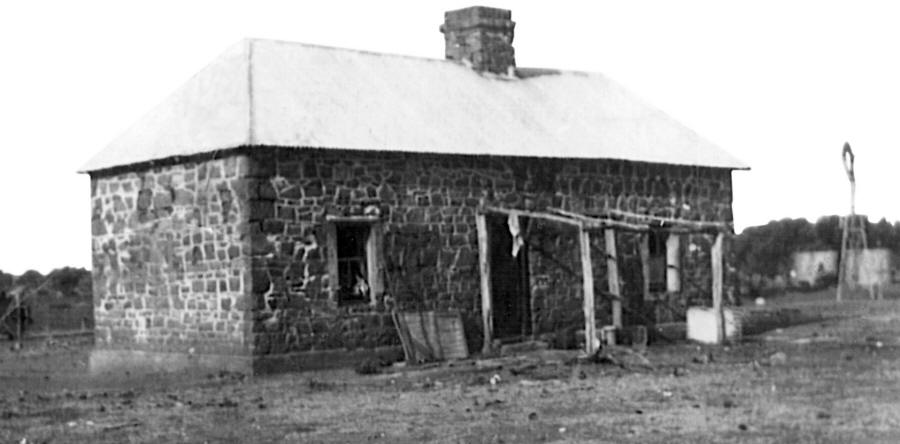
Above: Yarra Yarra Cottage - the Macpherson's first home in Carnamah
The Macpherson family built and initially lived in a three-room stone cottage near the Mulliah / Yarra Yarra Lakes. By 1869 they had built a much larger stone homestead a short distance from Carnamah Spring. Most of Carnamah eastward from the Yarra Yarra Lakes was held in pastoral leases by the Macpherson family and James Nairn of Noolooloo Station. Leases spanning the eastern outskirts of Carnamah were held by Bishop Rosendo Salvado of the Benedictine Monastery in New Norcia.
The last link of the northern telegraph line from Perth to Champion Bay (Geraldton) was connected at an outbuilding of their homestead in Carnamah in 1874. Duncan and Mary's daughter Maggie ran the telegraph office for 39 years and after the railway went through in 1894 she also ran Carnamah's first post office.
Below: Map showing pastoral leases in Carnamah in 1879
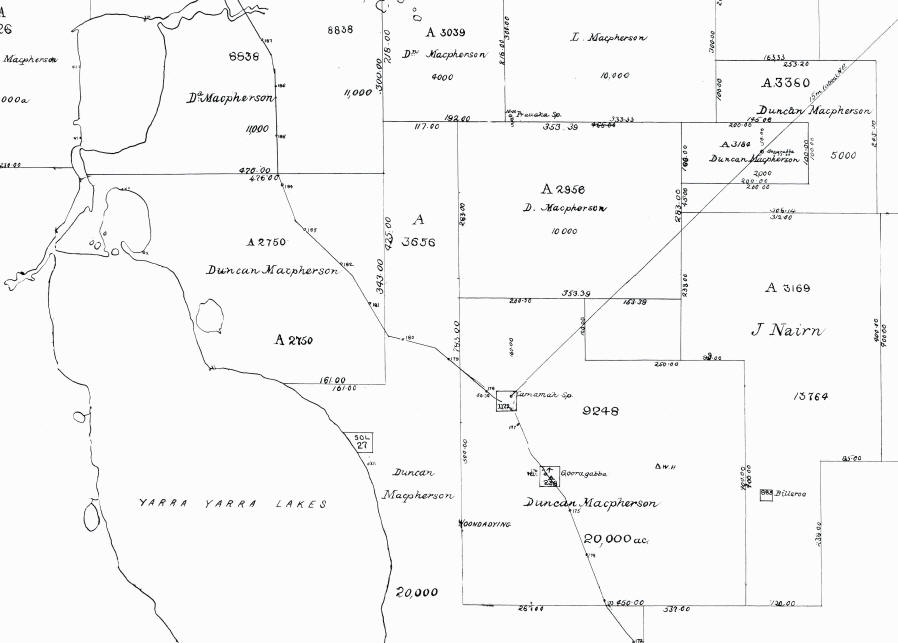
Mrs Mary Macpherson died in 1888 and her husband Duncan ten years later in 1898.
Their bodies were both returned to Toodyay to be buried alongside
the grave of their eldest son Aeneas, who had died before they moved
to Carnamah.
Two of their sons, Donald and George, took over the running of Carnamah Station. In addition to livestock pursuits they carted supplies out to Rothsay, and cut and carted timber for the Great Fingal Mine in Cue.
Right: George Macpherson (1863-1904)
Just before Christmas in 1904, while returning from a shooting expedition, George’s gun discharged and shot him in the arm. He was rushed to the railway siding and taken to Perth, where they amputated his arm. The operation went well however he was reported to have died from shock on Christmas Day.
Two of their sons, Donald and George, took over the running of Carnamah Station. In addition to livestock pursuits they carted supplies out to Rothsay, and cut and carted timber for the Great Fingal Mine in Cue.
Right: George Macpherson (1863-1904)
Just before Christmas in 1904, while returning from a shooting expedition, George’s gun discharged and shot him in the arm. He was rushed to the railway siding and taken to Perth, where they amputated his arm. The operation went well however he was reported to have died from shock on Christmas Day.
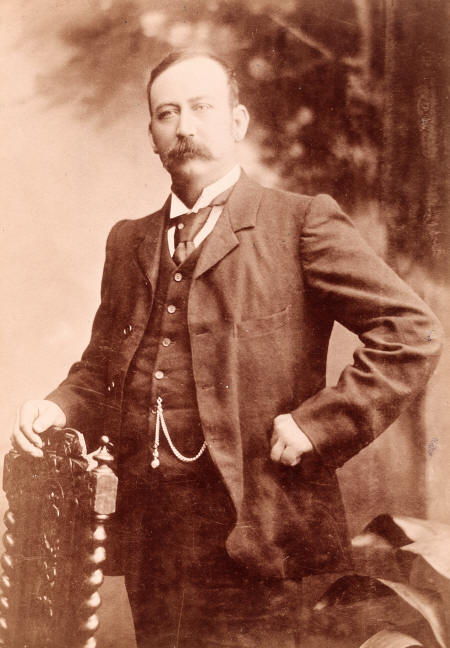
"...the happy face of everybody's well met
friend Donald Mac"
.
– The Midlands Advertiser newspaper, 24 March 1922
.
– The Midlands Advertiser newspaper, 24 March 1922
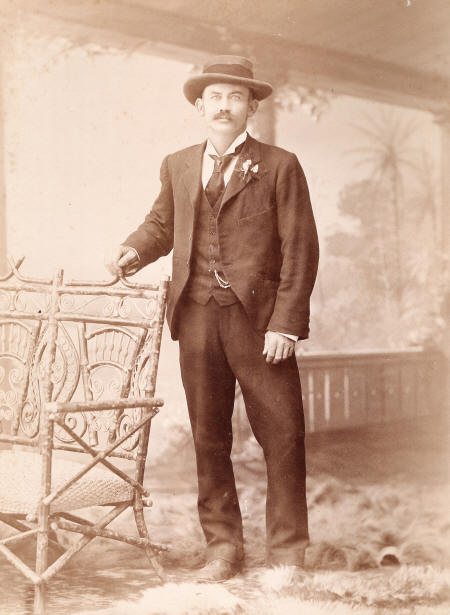
Left: Donald Macpherson (1858-1931)
Donald Macpherson was a boy when he settled in Carnamah with his parents. He witnessed the district transform from virgin bush to an established agricultural district with a well appointed townsite. As a result of his long residence, and time given to civic and sporting duties, he became known as the Father of Carnamah.
Below: Donald's initialled serviette ring
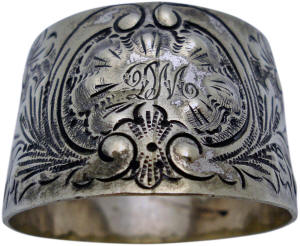
Donald Macpherson was a boy when he settled in Carnamah with his parents. He witnessed the district transform from virgin bush to an established agricultural district with a well appointed townsite. As a result of his long residence, and time given to civic and sporting duties, he became known as the Father of Carnamah.
Below: Donald's initialled serviette ring


Right: Carnamah Tommy outside Carnamah House
In the early years the Macpherson family employed Aboriginal people, Chinese immigrants and Ticket of Leave convicts. The convicts had been sentenced in England, India, Singapore and Bermuda for crimes of stealing, assault or mutiny. Part of their punishment was that they were transported to Australia. A "Ticket of Leave" was granted to those who behaved and allowed them to leave prison and get a job. The convicts likely helped build the family's homestead Carnamah House.
Carnamah Tommy was an Aboriginal man who worked for the family for many years as a shepherd. He was described as a phenomenal tracker who could skillfully locate any missing livestock.
"We had five horses... they weren’t there, and the fence was broken. I went to Donald Macpherson. He told me to take Carnamah Tommy and show him where they got out. This I did, but Tommy had to go home for sugar and tea before he set off tracking. This was Thursday. On Sunday Tommy came back with the horses. He had found them at the back of Arrino."
– Carnamah farmer James K. Forrester
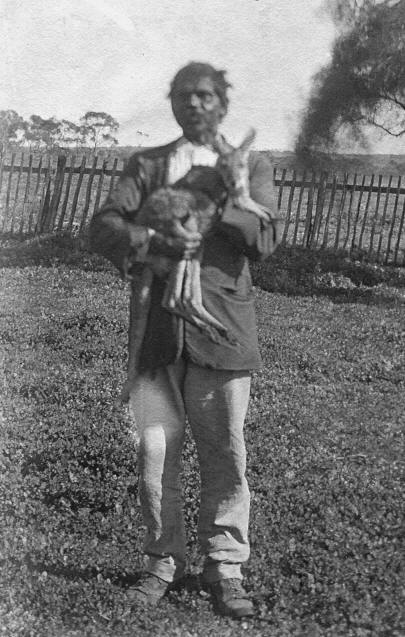
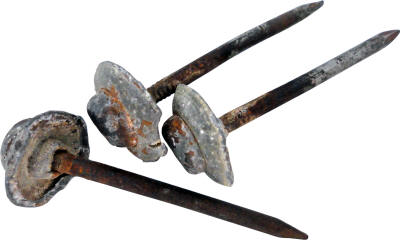
Left: Lead-top nails from the Macpherson's stables
In addition to their homestead the family built a number of outbuildings. These included two-roomed stone workmen's quarters, stables and another stone building that was used as the telegraph office and dairy house. Their kitchen and underground cellar was in a separate building next to the homestead but connected by a wooden walkway.
In addition to their homestead the family built a number of outbuildings. These included two-roomed stone workmen's quarters, stables and another stone building that was used as the telegraph office and dairy house. Their kitchen and underground cellar was in a separate building next to the homestead but connected by a wooden walkway.

Above: The Macpherson's Homestead "Carnamah House" and surrounds in 1906

Donald Macpherson was chosen to officially open the first
Carnamah Hall in 1921. During the ceremony he was gifted this silver key
(left) from the people of the district. The reverse side of the key
is
inscribed with his initials DM.
Donald was well known in WA as a breeder and contributor to horse racing. One of his horses that competed successfully in Perth and on the WA goldfields was named Carnamah. In 1922, just days before being captured, a local bushranger named Frank Thomas stole one of Donald's horses:
"... the man adopted a peculiar and ingenious method of catching this horse. He went to the trough where the horses usually went for their evening drink, and emptied it. The horse came up, and of course hung about to get a drink. Prisoner put half a bucket of water in the trough and as the horse was drinking, he caught it with the rope he had taken off the bucket."
– The Geraldton Guardian newspaper
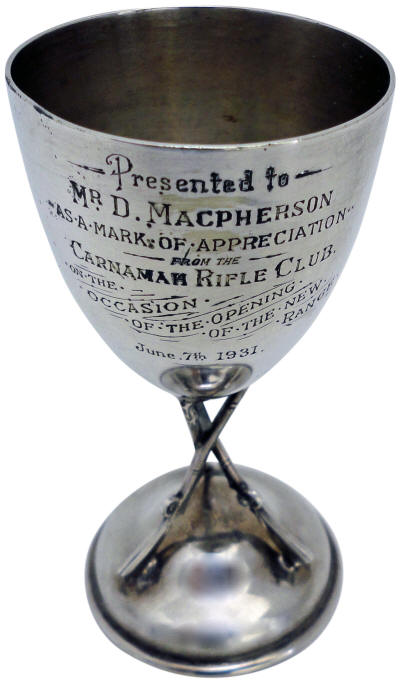
Above: Cup presented to Donald Macpherson in 1931
George, Donald and their sisters Maggie and Bessie never married and lived together at their family's homestead in Carnamah until their respective deaths.
Donald Macpherson died in 1931 and all local businesses were closed on the day of his funeral. This was as a mark of respect but also because over 300 people were attending his funeral. Many others sent flowers for his grave, including eight of Carnamah's Aboriginal families.
Donald was well known in WA as a breeder and contributor to horse racing. One of his horses that competed successfully in Perth and on the WA goldfields was named Carnamah. In 1922, just days before being captured, a local bushranger named Frank Thomas stole one of Donald's horses:
"... the man adopted a peculiar and ingenious method of catching this horse. He went to the trough where the horses usually went for their evening drink, and emptied it. The horse came up, and of course hung about to get a drink. Prisoner put half a bucket of water in the trough and as the horse was drinking, he caught it with the rope he had taken off the bucket."
– The Geraldton Guardian newspaper

Above: Cup presented to Donald Macpherson in 1931
George, Donald and their sisters Maggie and Bessie never married and lived together at their family's homestead in Carnamah until their respective deaths.
Donald Macpherson died in 1931 and all local businesses were closed on the day of his funeral. This was as a mark of respect but also because over 300 people were attending his funeral. Many others sent flowers for his grave, including eight of Carnamah's Aboriginal families.
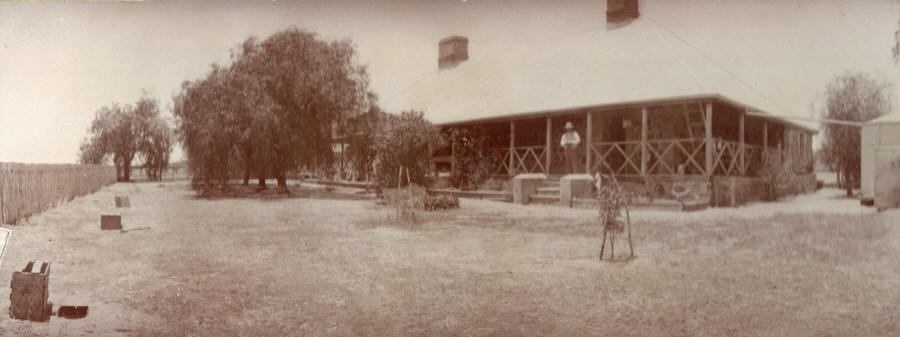
Above: The Macpherson's homestead "Carnamah House" with Donald standing on the front steps in 1911
Miss Macpherson's candle powered
buggy lamp
A lit candle provided light on the buggy when used to travel from the homestead to social events held in Carnamah.
Mary E. Kelly (née Niven), looking back on her childhood in Carnamah in the 1910s and 1920s, remarked:
"A memorable outing was an invitation to the Macpherson’s. It was like going to Buckingham Palace to us – that lovely old stone house and hand-hewn timbered verandas, the peacocks, the pepper trees, gravelled surrounds, retired racehorses, the meal house and dairy. They always had Aboriginals to help with the work on their property. We wore our best and were on our best behaviour. Can still see the dining room with starched snowy white linen, serviettes and silverware. Miss Macpherson would ring for whoever was on duty to serve."
Miss Bessie Macpherson died in 1939 leaving the district and town void of its founding family. The Macpherson name lived on, and continues to, as the name of Carnamah's main street.
In her will Bessie bequeathed her estate to her nephew's son Malcolm J. C. Macpherson, who before leasing the family's homestead, took only a small pile of silverware. For more on the homestead, see www.carnamah.com.au/homestead
A lit candle provided light on the buggy when used to travel from the homestead to social events held in Carnamah.
Mary E. Kelly (née Niven), looking back on her childhood in Carnamah in the 1910s and 1920s, remarked:
"A memorable outing was an invitation to the Macpherson’s. It was like going to Buckingham Palace to us – that lovely old stone house and hand-hewn timbered verandas, the peacocks, the pepper trees, gravelled surrounds, retired racehorses, the meal house and dairy. They always had Aboriginals to help with the work on their property. We wore our best and were on our best behaviour. Can still see the dining room with starched snowy white linen, serviettes and silverware. Miss Macpherson would ring for whoever was on duty to serve."
Miss Bessie Macpherson died in 1939 leaving the district and town void of its founding family. The Macpherson name lived on, and continues to, as the name of Carnamah's main street.
In her will Bessie bequeathed her estate to her nephew's son Malcolm J. C. Macpherson, who before leasing the family's homestead, took only a small pile of silverware. For more on the homestead, see www.carnamah.com.au/homestead
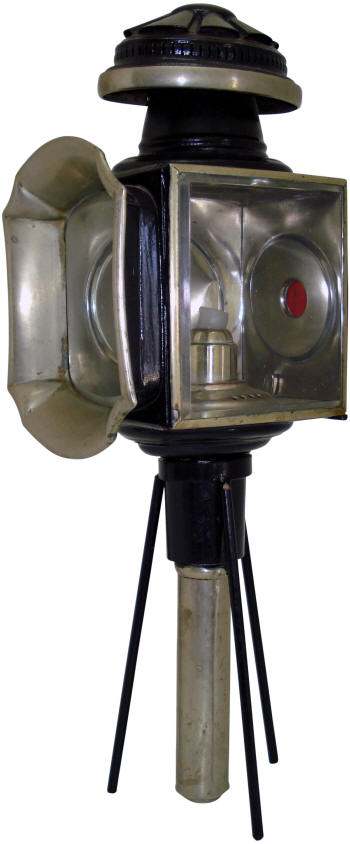
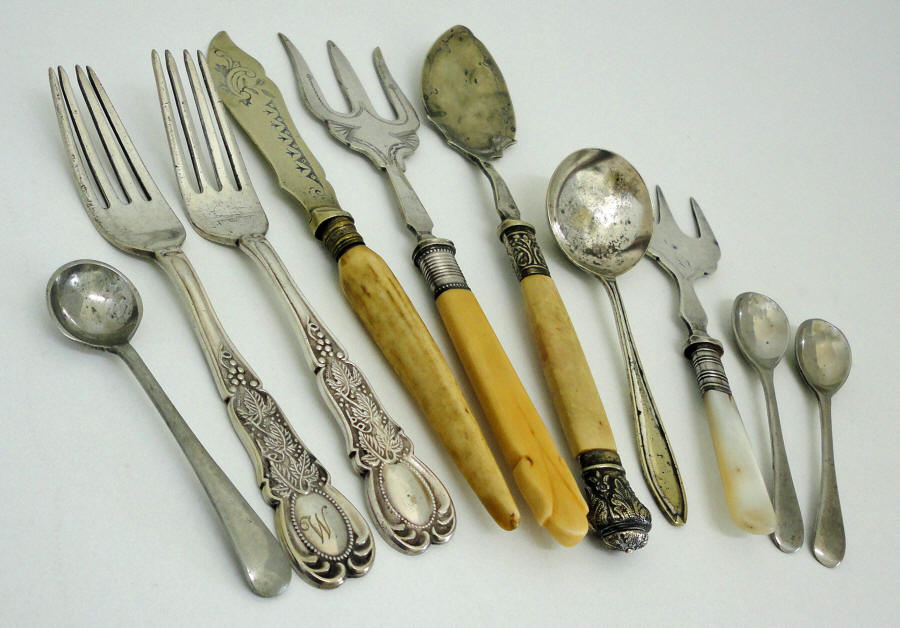
Above: Cutlery taken from the homestead in 1939 by its inheritor Malcolm J. C. Macpherson
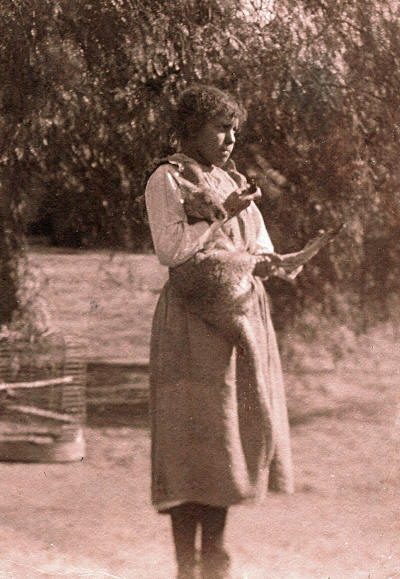
Left: Jessie Nebrong / Dido at Carnamah House
There's a chapter of Carnamah history that was reduced to whispers and never openly spoken about. Duncan Macpherson or his son Jock had two children, Albert Nebrong and Frances Nintigian, with a local Aboriginal woman who was known as both 'Buddy' and Mary Wirbina. Despite the secrecy, their son Albert Nebrong worked as a stockman with the family in Carnamah.
Albert had a daughter Jessie, who later worked at the Macpherson's homestead doing domestic chores. Jessie's partner was Aboriginal man Dido, who was a shepherd for the family. They lived in the bush near the homestead until Donald Macpherson's death in 1931 but then, with no employment, had to move away.
"I knew from my father that Jessie Dido had something to do with the family but he never said in which way. I can remember whenever we stopped at Carnamah and Jessie was seen, Dad would give her five pounds."
– Ian, son of Malcolm J. C. Macpherson
There's a chapter of Carnamah history that was reduced to whispers and never openly spoken about. Duncan Macpherson or his son Jock had two children, Albert Nebrong and Frances Nintigian, with a local Aboriginal woman who was known as both 'Buddy' and Mary Wirbina. Despite the secrecy, their son Albert Nebrong worked as a stockman with the family in Carnamah.
Albert had a daughter Jessie, who later worked at the Macpherson's homestead doing domestic chores. Jessie's partner was Aboriginal man Dido, who was a shepherd for the family. They lived in the bush near the homestead until Donald Macpherson's death in 1931 but then, with no employment, had to move away.
"I knew from my father that Jessie Dido had something to do with the family but he never said in which way. I can remember whenever we stopped at Carnamah and Jessie was seen, Dad would give her five pounds."
– Ian, son of Malcolm J. C. Macpherson
Albert Nebrong died in 1939 but rose to
national fame in 1947 when it was claimed that during his life he
had cured himself of tongue cancer. Albert had used the extract of a
native plant known as the Maroon bush.
V i r t u a l M u s e u m :
Railway ● Farms ● War ● Town ● Schools ● Roads ● Business ● Milk ● Electricity ● Tearooms ● Post ● Books ● Toys
Now featuring 10863 Bushranger presented by Act Belong Commit














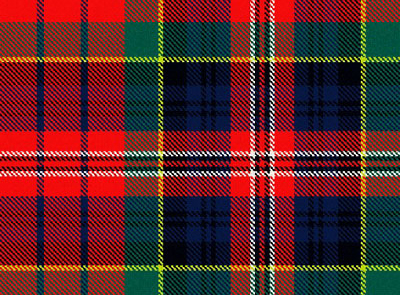
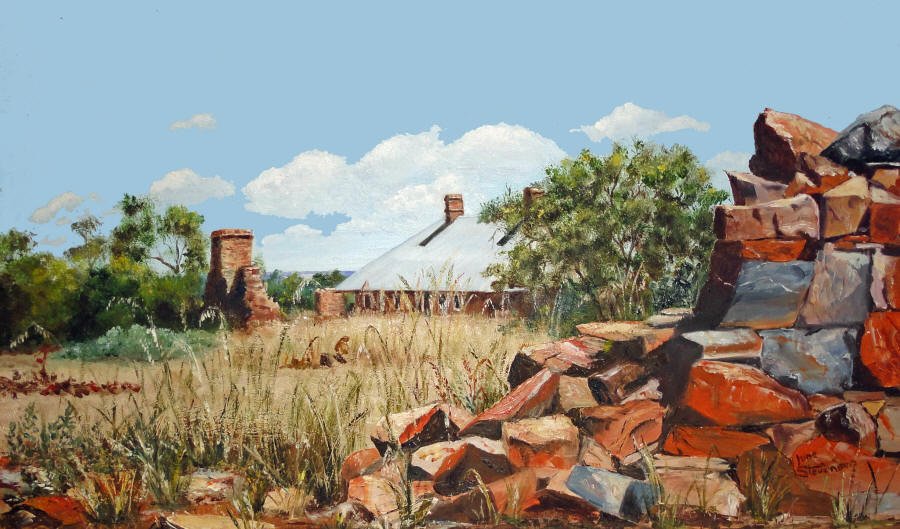



Carnamah Historical Society & Museum
For more on the Macpherson Family, see our blog post 150th Anniversary of the Macpherson Family in Carnamah, check out North Midlands Project's online exhibition A Pastoralist Family or look up members of the family in our Biographical Dictionary.
Please help enrich our collective history by sharing your own comment, story, memories or photos about the Macpherson Family or their homestead in Carnamah. Send us an email to history@carnamah.com.au or use our online comment form.
Valerie McCooke (nee Pearce)
My Mum (Coral Pearce nee Bentley) worked at the Macpherson homestead for six years. She told happy stories about her working and social life whilst she was there. Her bedroom was the first on the left inside the door (now a store/kitchen when I last visited). I recall mum speaking of Jimmy, and also of other Aboriginal people that were employed by the Macphersons to take care of the horses. I spent many happy days at the homestead myself when Mr and Mrs Ferguson owned the property. Playing in the old kitchen with Sheryl and Judy Reibi, daughters of Peg Ferguson. What a wonderful collection of photos and memories on the web site. Well done to all concerned. Valerie.
Ian M Macpherson
One of the stories I have heard was that Duncan and one of his employees went down to Gin Gin for supplies, a case of whiskey was one of the items obtained. This case was consumed some miles out on the way back to Carnamah so Duncan turned around and obtained another case before proceeding home.
JK Foresster
They built their homestead near a spring of water. They made their dam not far from where Langs [later] settled. They made this dam with pick and shovel and wheelbarrow. They never farmed to any extent, but grew oats that they could cut for their horses. They ran sheep but poison was a problem on the hill east of Carnamah. The sheep were shepherded by natives. I knew Carnamah Tommy. He was a splendid tracker. Dido was also a very good tracker. Carnamah Homestead used to be the Post Office for a very huge area. The mailman rode from Guildford once a week and went as far as Port Denison. All this changed with the Midland Railway.
Mary Kelly
Miss Macpherson had a riding accident and suffered a nasty injury to her face and nose. A Mrs Durack I think attended her in her home as a stake had caused a nasty wound and would have required dressings. My sister Margaret [Niven] was employed there and helped Mrs Durack and I guess she had other duties. Margaret used to ride one of Macpherson’s horses – side saddle in those days – and would come to see us on her afternoon off. The horse was named “Home-Again”. She loved it of course and enjoyed her outings.
Jim Taylor
Donald Macpherson and his sister were mad, mad mad, keen bridge players, all night long. Mother and Father, Bessie and Donald played. Bessie was Donald's sister - she never married. There were many arguments during bridge. Some were half asleep by 2am.
Donald was a likeable sort of a man. He couldn’t walk very great distances because he had had a very bad rupture – that sort of slowed him down quite a bit. Not that he had to do a great deal of walking because the building that was behind the kitchen was where Jim Crowe, a tribal elder, and Old Tommy, the stockman, used to camp. Donald only had a short walk to tell them what to do –, clean out the mills, check the fences or whatever he had in mind. He was funny in one way. If, at the table, he asked you if you wanted something you had to answer “Yes Please” or “No thank you”. After any kind of get together the men retired to the lounge room for a tote of Scotch whisky.
He was pretty well liked. He was never one of the blokes to go down town drinking booze or anything like that. If he went anywhere it was always in his car out to someone’s farm. He had quite a nice car. It was the first car to come out with disc wheels. It was a Nash – pretty big car. It had a funny thing about it. Up to about 25 mph the front wheel used to wobble, when you pushed it over that, it sorted itself out. There must have been a defect there or something.
I can remember the last time that I was in Donald Macpherson’s place. The Old Man was in Three Springs Hospital having his right index finger treated and eventually amputated and I was on the farm on my own, and they reckoned that wasn't right, so I had to live at Macpherson’s. I slept out on the verandah just underneath the window of that little room. It had a sort of alcove there. Old Donald had his mattress down there and that is where he used to camp. That’s where he died. Next morning when I found out – of course the whole house was in chaos – I took to my heels and went straight down to school, no breakfast or anything. That was the last time that I ever went to Macpherson’s place. From there I went back onto the farm and I stayed there on my own. My father was up in hospital for quite some time. It was no problem for me as I used to do all of the cooking anyway. Parrick drove the car up to get me but I laid low.
Kerry Kelly nee Farrell, daughter of Arthur and Elizabeth Farrell
Thank you for the information I found of my father Arthur Farrell and also my grandmother Jessie Nebrong my father's mother. I am also looking for war photos of my dad. Once again thank you.
Les Johnson
I can remember when I was young seeing lots of cars going through town and being told they were all the cars going to Donald Macpherson’s funeral. On one occasion I recall going to the Macpherson’s Homestead when I was quite young. My mother and Miss Bessie sat down at the table and gave me a piece of watermelon. I can always remember wishing they’d give me another piece! Jessie Dido, who worked there, sat at Miss Bessie’s feet.
Glen McPherson
Enjoyed the web site.
From Vancouver Island, British Columbia
Keith Mulligan
The original road through Carnamah went past Macpherson’s house and a coach used to come through that would bring the mail. I used to go rabbiting there with Teddy Edwards, an Aboriginal who did odd jobs up there. Teddy Edwards and an old Irishman Paddy Ryan showed me all the waterholes. They said “you know, we don't have to worry about carrying water out here.” Paddy would get his little billy and get some fresh water out and hang it above his cart so it would be nice and cool. Behind Macpherson's about half a mile back is a rock outcrop. We went there and he lifted this flat sheet of rock up and there was this fresh pool of water. You could empty it out and go back in an hour and it would be full again.
Brandon Macpherson
This is a very interesting site
Helen Green (nee Rowland)
I used to go to Macpherson’s house when I was a little girl because Dad broke horses in for Donald Macpherson. Miss Macpherson always had cakes and biscuits. They had domestic help and Miss Macpherson didn’t get her hands dirty. She thought my mother was a bit funny I think because she’d get in the pigsty and feed the pigs and do all sorts of things. Miss Macpherson – no way! It’s a beautiful old homestead.
Annette O'Grady
My Great Great Grandfather William Woodhouse Kett was sent to Western Australia in 1862 as a convict (10 years for Larceny) and imprisoned in Fremantle Goal. A year later he received his Ticket of Leave and was sent to Toodyay as a Clerk, working for a Mr Meade. This was probably Thomas Mead who owned the Hotel.
At the end of 1863 his records show that his master was a D. MacPherson, and that he was firstly a Schoolmaster for them and subsequently became a Tutor in 1864. I suspect it was Duncan & Mary MacPherson and he was employed to tutor their children. He would of been chosen as tutor as, despite his crimes, he was a well educated man from a respected family in England.
He went back to Perth in 1865 and started his own business. Hoping that this snippet might be of interest to the Macpherson story. Unfortunately I have no photos of William to forward on... hoping one day I might find some.
Cecil (Sid) Bruce Macpherson
Stumbled upon this fantastic history. As a Macpherson this has stimulated my curiosity on whether I may have links to these folks. I was born in Katherine N.T. in 1970 and my mother and grandmother where residents of Katherine. I am quite naive to my immediate family history sadly and would benefit from any insight.